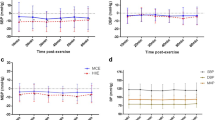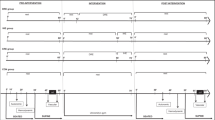Abstract
Abstract
Combined aerobic-anaerobic exercise seems to be a valid, non-pharmacological way to reduce hypertension. Circuit training (CT) is often used to train normotensive (N) and hypertensive (H) subjects, but not all circuits are equal and some exercises could be dangerous for H subjects. The objectives of the study, carried out in accordance with the Basic Principles of the Declaration of Helsinki, were to assess the trend of blood pressure response in N and H subjects during a CT session; define which exercises in CT are most safe for H subjects; and verify the possible risks of a CT session to excessively raise blood pressure in H subjects.
Methods
Ten N and 10 H subjects, moderately trained males, were enrolled. Arterial blood pressure was measured at rest and at the end of each exercise. Heart rate (HR) was recorded by a heart rate monitor. Subjects performed at 7 CT stations: bike 65, 70 and 75% of HRmax, leg press, leg extension, leg curl and squat.
Results
Mean arterial blood pressure was significantly higher in H than N subjects. Leg curl, leg extension and bike at 65% HRmax were the mostly clinically safe. Bike at 70–75% HRmax, isometric squat and leg press exceeded the safe limit.
Conclusions
It is necessary to monitor blood pressure during a CT programme with bike at 70–75% of HRmax, isometric squat and leg press as they were shown to be a potential risk for H subjects.
Similar content being viewed by others
References
Slama M, Susic D, Frohlic ED (2002) Prevention of hypertension. Curr Opin Cardiol 17:531–536
Lee J, Ma S, Deng D et al (2008) Hypertension, concurrent cardiovascular risk factors and mortality: the Singapore cardiovascular cohort study. J Hum Hypertens 22:468–474
Appel LJ (1999) Non-pharmacologic therapies that reduce blood pressure: a fresh perspective. Clin Cardiol 22[Suppl III]:1–5
Kelemen MH, Stanforth PR, Valenti SA et al (1990) Exercise training combined with antihypertensive drug therapy. Effects on lipids, blood pressure and left ventricular mass. JAMA 263:2766–2771
Hagberg JM, Park JJ, Brown MD (2000) The role of exercise training in the treatment of hypertension: an update. Sports Med 30:193–206
Moreno H Jr, Cezareti ML, Picarro IC et al (1995) The influence of isotonic exercise on cardiac hypertrophy in arterial hypertension: impact on cardiac function and on the capacity for aerobic work. Comp Biochem Physiol A Physiol 112:313–320
Kukkonen K, Rauramaa R, Voutilainen E, Lansimies E (1982) Physical training of middle-aged men with borderline hypertension. Ann Clin Res 14[Suppl 34]:139–145
Whelton SP, Chin A, Xin X, He J (2002) Effects of aerobic exercise n blood pressure: a meta-analysis of randomised, controlled trials. Ann Intern Med 136:493–503
Brandao Rondon MU, Alves MJ, Braga AM et al (2002) Postexercise blood pressure reduction in elderly hypertensive patients. J Am Coll Cardiol 39:676–682
Halbert JA, Silagy CA, Finucane P et al (1997) The effectiveness of exercise training in lowering blood pressure: a meta-analysis of randomised controlled trials of 4 weeks or longer. J Hum Hypertens 11:641–649
Tipton CM (1984) Exercise training and hypertension. Exerc Sport Sci Rev 12:245–307
Harris KA, Holly GR (1987) Physiological response to circuit weight training in borderline hypertensive subjects. Med Sci Sports Exerc 19:246–252
Kelley GA, Kelley KS (2000) Progressive resistance exercise and resting blood pressure: a meta-analysis of randomised controlled trials. Hypertension 35:838–843
Katz J, Wilson BR (1992) The effects of a six-week, low intensity Nautilus circuit training program on resting blood pressure in females. J Sports Med Phys Fitness 32:299–302
Kaplan NM (1987) Nonpharmacologic therapy of hypertension. Med Clin North Am 71:921–933
Appel LJ (1999) Non-pharmacologic therapies that reduce blood pressure: a fresh perspective. Clin Cardiol 22[Suppl III]:1–5
Kanakis C, Hickson RC (1980) Left ventricular responses to a program of lower-limb strength training. Chest 78:618–621
Guerrera G, Melina D, Felici C et al (1990) Valutazione della validità predittiva di ipertensione stabile al test ergometrico nell’ipertensione borderline. Cardiologia 35:997–1004
Fagard RH (2001) Exercise characteristics and the blood pressure response to dynamic physical training. Med Sci Sports Exerc 33:S484–494
Author information
Authors and Affiliations
Corresponding author
Rights and permissions
About this article
Cite this article
Margonato, V., Cè, E. Potential hypertensive risk during circuit training in normotensive and first-degree hypertensive subjects. Sport Sci Health 5, 71–74 (2009). https://doi.org/10.1007/s11332-009-0080-z
Received:
Accepted:
Published:
Issue Date:
DOI: https://doi.org/10.1007/s11332-009-0080-z




